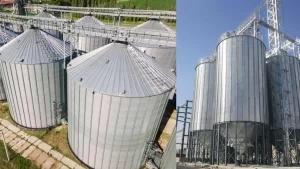Grain bins and silos are two of the best-known types of Grain Storage Silos towers on farms these days. Understanding the fundamental differences between these farmland staples is essential for choosing the right structure for your farming facility. Depending on your work, your budget and the amount of space you have to work with, either choice will be better for your purposes.
In contrast, silos are designed for long-term storage and can hold both dry grains and silage, often being airtight to preserve the stored material. The choice between a grain bin and a silo depends on factors such as storage duration, crop type, and access needs.

What Are Grain Bins?
Grain bins typically look like broad, short buildings made from corrugated or smooth metal. Corrugated metal grain bins tend to have a uniform shape of a peaked roof atop a cylindrical body, often with doors and ladders on their sides. While grain bins are a popular grain storage system option for small farming operations, they are also common in more extensive grain storage facilities.
In general, grain bins feature various ventilating elements, such as temperature systems and roof vents, because they require ample airflow. Well-engineered, premium grain bins will also include these components to meet the needs of today’s complex agricultural environment.
- A high-capacity roof designed to handle heavy snow and equipment loads, such as supporting large conveyors
- Easy-open access doors that don’t require any tools and are two rings tall, so there’s no need to squeeze
- A sturdy tubular handrail next to the roof opening to assist a smooth entry and exit
- A high-strength aeration floor that facilitates sufficient, uniform air distribution and simplified cleaning
- Cushion boxes to protect the grain from potential harm during free fall by providing a soft landing
- Advanced grain aeration systems that combine the highest-quality fan and ventilation options to keep grain from spoiling or getting damaged
- Flow valves that control the rate at which the grain moves through the grain handling system
- Safety precautions and comfortable egress options, such as a ladder-climbing system with rest platforms and a case, adequate eave platforms and handrails along the path to the bin peak
- Single-piece steel lids that seal shut for a weather-tight fit and open broadly to provide a space wide enough to receive portable conveying equipment
- A solid foundation designed to support the massive grain weight while keeping the entire grain bin structure secure in high winds and other inclement conditions
What Is a Grain Bin Used For?
A grain bin is used to store harvested grain before it is sold, transported, or processed. Farmers rely on grain bins to keep their crops safe from weather conditions, pests, and spoilage while waiting for favorable market prices. These structures provide an efficient way to manage large quantities of grain by allowing for proper aeration, reducing excess moisture, and preventing mold or insect infestations. Additionally, grain bins enable farmers to store grain at their convenience, reducing dependency on third-party storage facilities and lowering overall costs. With advanced technology, modern grain bins are now equipped with temperature monitoring systems and automated aeration controls, further enhancing their effectiveness. Proper grain bin management ensures a steady supply of high-quality grain for food production, livestock feed, and other agricultural applications.
What Are Silos?
Silos are another staple of grain storage that are typical features on farms with cattle, but are sometimes on other farms, too. Silos are easily recognizable for their distinct tall, slim structure. A silo can consist of various materials, including concrete, metal, brick and wood.
- Tower: A tower silo is a familiar farmland sight with its traditional tall cylindrical shape. The tower silo’s stretched-out design makes it convenient to fit multiple silos on a smaller plot of land. Though most farmers load and unload from the top of the silo, bottom unloaders do exist.
- Bunker: A bunker silo is a trench consisting of human-made walls and a natural earth floor. Bunker silos are most often concrete structures covered with airtight tarps to protect the goods inside. To load and unload materials in bunker silos, farmers use tractors and loaders.
- Bag: As its name implies, a bag silo involves using plastic bags to store goods. Bag silos are airtight to shield their contents from external factors and can be more efficient than conventional silos because of their flexibility. While a bag silo cannot store quite as much as tower or bunker silos, it can house a substantial amount of goods within a compact space.
What’s a Silo Used For?
A silo is used for the long-term storage of grains, silage, and other bulk agricultural products. Silos help farmers preserve crops by maintaining controlled environmental conditions that prevent spoilage, pests, and contamination. They are especially useful for storing fermented feed for livestock, known as silage, which requires airtight conditions to support the fermentation process. Additionally, silos are often used in large-scale grain storage operations, where keeping grains in optimal condition for extended periods is crucial.
The design of silos, whether tower, bunker, or bag silos, allows for efficient space utilization and better inventory management. Modern silos are often equipped with monitoring systems that track temperature, moisture levels, and grain quality, ensuring effective storage and reducing waste. By using silos, farmers can maintain a steady supply of feed and grains throughout the year, improving overall farm productivity and sustainability.
Silo vs. Grain Bin
When it comes to storing grains, two common structures are often discussed: silos and grain bins. While they may seem similar at first glance, they have distinct differences that cater to different needs and operations in agriculture. In this article, we will break down the key differences between a silo and a grain bin, their unique features, advantages, and which one might be the best fit for your grain storage needs.
While both are viable grain storage options, grain bins and silos have a few crucial differences that affect which structure is right for a farming operation. Ultimately, the main distinctions between grain bins and silos break down into three categories — appearance, grain storage and function.
1. Silos and Grain Bins Have Unique Appearances
While grain bins and silos are both cylindrical, there are a few notable differences in their looks. Grain bins can vary in shape, ranging from squat and broad to tall and slender, and have peaked roofs typically made of metal. However, silos tend to be more uniform in shape, but vary in materials. Silos are generally slimmer and taller with a domed roof and come in concrete, metal, brick or wood.
2. Grain Bins Store Grain While Silos Store Silage
An essential difference between silos and grain bins is the type of grains they store. Grain bins store dry grains, such as wheat, corn, oats, seeds, soybeans and barley, most commonly used for human consumption or to make fuel. On the other hand, silos are ideal for storing the fermented pasture grasses known as silage, which feed livestock throughout the winter.
3. The Function of These Grain Storage Towers Differ
Because they store different types of grains, silos and grain bins have inherently distinct functions. A silo’s unique design promotes fermentation to preserve the silage. In contrast, a grain bin’s purpose is to keep its contents dry, undamaged and pest-free. To accomplish this, a grain bin must allow for adequate aeration and maintain appropriate humidity and temperature levels to prevent spoilage.
Contact Prairies Partners Global Solution to Discuss Your Grain Bin Options
If you’re considering investing in a grain bin for your agricultural needs, look no further than Prairies Partners. We offer expert guidance and a range of high-quality grain bin options designed to suit various capacities and operational requirements. Our team is committed to helping you make the best decision for your farm’s storage needs.
Why Choose Prairies Partners Global Solution?
- Expert Advice: Our team has years of experience in the agricultural sector, offering insights tailored to your specific requirements.
- Top-Quality Grain Bins: We work with leading manufacturers to provide durable, reliable, and efficient grain storage solutions.
- Customized Solutions: Whether you’re storing grain for the short-term or long-term, we can help design a grain storage system that meets your needs.
Whether you’re looking to explore your options or have questions about the best grain bin for your farm, our experts are ready to assist you. Reach out to us today, and let’s start the conversation on how we can help optimize your grain storage.
Contact Us:
- Phone: +919310139381
- Email: info@prairiespartners.com
- Website: https://www.prairiespartners.com/

